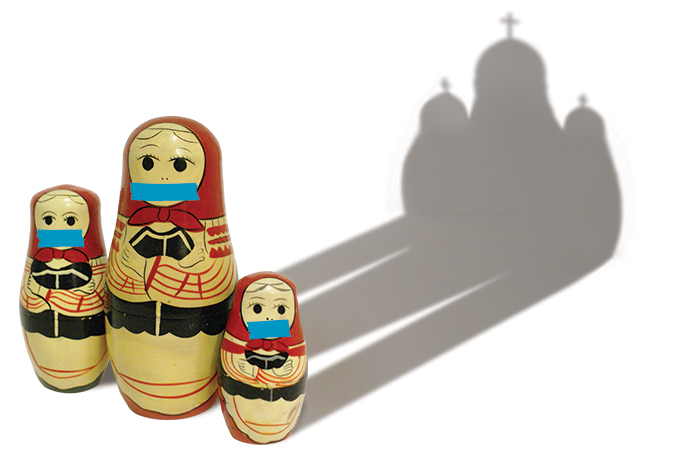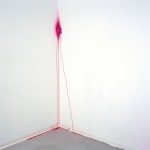On February 21, 2012 the Russian feminist performance art group Pussy Riot performed a “punk-prayer” in Moscow’s central Russian Orthodox Church. Footage of the performance shows four women wearing the group’s emblematic balaclavas and colorful dresses, singing, jumping and crossing themselves beside the altar for approximately ninety seconds before they were chased out of the cathedral.
Local authorities issued a warrant on charges of “hooliganism” — a sentence that can receive up to seven years in Russia’s prisons — for Nadezhda Tolokonnikova (Nadya, 22, philosophy student and mother), Maria Alyokhina (Masha, 24, poet, student of journalism and mother) and Yekaterina Samutsevich (Katia, 29, graduate of Rodchenko School of Art). Nadya and Masha were sentenced to two years in penal colonies and Katia was released on probation.
The punishment ignited widespread international condemnation. Amnesty International proclaimed them “prisoners of conscience,” and, in a concert in Moscow in August, Madonna infamously wrote “Pussy Riot” on her skin. The artistic merit of the punk-prayer work earned Pussy Riot the #57 ranking on the latest ArtReview Power 100 List and is a candidate for the prestigious Kandinsky Art Prize. Celebratory reenactments of the performance have been numerous outside of Russia, including a homage in the name of free speech and feminism at Chicago’s Debonair Social Club.
In July, I arrived in Moscow via an overnight train from St. Petersburg. I was picked up by friend, poet and gallery owner Alexey Sosna who drove through the madness of Moscow’s traffic into the the heart of the controversy brewing outside the Moscow courthouse where the second hearing of Nadya, Masha and Katia was being held. Along the way, Alexey stopped by what he called an “authentic and yet totally underground gem” of a cheburek joint (meat patties from Georgia, a common street food). He ordered several chebureks, and after singing an Orthodox prayer with his characteristic bravado and gesticulation — as grease slid down his sleeves — told me about how Russia is occupied by thieves and bandits. While he considers immigrating for the sake of his family (he has three kids), he could never go anywhere else because he can’t live without the local “extreme.”
When we left the restaurant, Alexey’s car, which he had parked in a way that blocked traffic from all directions, was being ticketed by a police officer. Unperturbed, Alexey approached the cop and embraced him. With typical Moscow swagger he whispered something that began with “Bro…” and slipped some “change” into the cop’s pocket. In the car, Alexey said that he once tried to obey the law for a single day, but within a few hours he was convinced it was impossible in contemporary Russia; the place will eat you alive.
I crossed myself with each impossible turn as Alexey recited stanzas of Pushkin, Brodsky or his own poetry, driving twice the speed-limit the rest of the way to the courthouse.
Before my Moscow visit I had heard about Pussy Riot, seen the video, and I found their action repulsive. I knew about Voina — an activist art group that included several members of today’s Pussy Riot — who, in a 2008 event, had group sex on the floor of the Biological Museum. They were also responsible for 2010’s “How to Snatch a Chicken,” where a female Voina member stuffed a frozen chicken into her vagina and walked out of a St. Petersburg supermarket without paying. These acts, largely unknown by many of the individuals who embrace Pussy Riot in the Western world, were difficult for me to celebrate for a simple reason: there were children watching. I was therefore surprised to learn my friend Alexey, one of the most devout Russian Orthodox people I know and an intellectual and cultural snob, supported Pussy Riot. Shrugging, he told me that although he does not approve of the action, he cannot condemn it either.
Many in Russia share this contradictory, complicated response to Pussy Riot. This dichotomy became even more apparent to me as we joined the hundreds of people and media representatives outside the Moscow courthouse. The people that came to the demonstration were of all different backgrounds and convictions — professors and monks and artists and hard-core Putin supporters. Some argued that if Russia was functioning properly, the performance would be allowed to remain an “art performance” and merely punished by a state fine. On the other hand, I met a man who quoted Immanuel Kant and said that the girls should be stoned to death. Yes, Russia is “extreme.”
Meanwhile, in the adjacent building, Masha, Katia and Nadya were accused by the prosecuting attorneys of “spitting into the souls of the Orthodox people.” The ultimate wager was whether the corruption at every level of law and religion that had become standard practice in contemporary Russia left anything sacred enough to be soiled by being spat at.
Russia, baptized in 988 A.D. by Prince Vladimir of Kiev, is frequently referred to as “Holy Russia” because of the proliferation of Orthodox values into religious, intellectual and everyday practices. As Dostoevsky famously said, “To be Russian means being Russian Orthodox.” While the accuracy of Dostoevsky’s quote may be questionable in Russia’s changing social body, it is impossible to speak about Pussy Riot without having a sense of the canon and role of Orthodoxy in Russian culture.
Of utmost concern in the public and court debate about Pussy Riot is the question of sacrilege. Blasphemy, or sacrilege, is peculiar in that it can transform into a holy act of revelation if it manages to reveal a larger evil. In their closing statements, Nadya and Masha explicitly referred to the trial of Jesus Christ, and they implied their place among the legacy of Russian dissident intellectuals such as Alexander Solzhenitsyn and the Raskolniki — named for the “Crime and Punishment” character who is an icon for those who break with the Orthodox Patriarchy to practice their own “pure” Orthodoxy.
Although the Pussy Riot act was condemned by Russian Orthodox Patriarch Kirill as being the “laughter of the Devil,” many people see the Pussy Riot performance as a revelation and the members as “holy fools.” Among their number are several priests who resigned in response to the official statement of the church.
Media footage of hundreds of people singing prayers or holding up icons both for and against Pussy Riot, or of people attacked on the street for wearing “Free Pussy Riot” emblems, circulate widely. The cacophony of the voices that have been summoned by the debate makes it difficult to do justice to what Pussy Riot really means for Russians. The performance has effectively peeled off the crust and poked at one of the haunting wounds of today’s Russia: the corrupt networks that unite the Holy Orthodox Church and the government in an illusion of state-issued spirituality is reminiscent of Soviet era cooperation between the church and KGB. Catching the climax of anxious sentiment that had been aroused by the fraudulent election of Vladimir Putin that March, Pussy Riot has revealed a divided social body — one side is convinced the country is being occupied by “bandits,” as my friend Alexey calls them, and the other believes or benefits from this status-quo.
What is much less discussed, in fact, almost forgotten, is the feminist and performance art reading of the work, something the imprisoned members of the group did not discuss in their court statements. And yet, Pussy Riot as an art group reference Actionism in America, Third Wave Feminism and the Guerilla Girls. And yet, as with many works of art before it, the shattering social effect of the work becomes much more pronounced than the aesthetic or critical ingredients themselves.
I do not believe dismissing the artistic component of the Pussy Riot action necessarily shows that people do not care about performance art or women’s rights. It simply underlines how what the Pussy Riot action ended up uncovering is much more radical than either art or women’s rights — a social body with a schism deep enough to ignite revolution. Pussy Riot posed the question of how Russian values, embedded in the Orthodox intellectual tradition through literature and history, are to be practiced given the state of the country today.
When I returned to Chicago I witnessed a very different conversation at SAIC, where no Russian Art class is taught. I had qualms about participating or fully understanding this American version of the discourse — it felt as if we were talking about two different things. I saw many people celebrating Pussy Riot’s purported anti-religious, feminist, free-speech stance. It was as if “the American” elements of Pussy Riot had been completely adopted by the post-Occupy culture industry with pop-up reenactments because of the appeal of the controversial name. It also seemed that the entirety of the context and stake of the Pussy Riot act in the Cathedral of Christ the Savior had been lost in translation for the benefit of an anti-religious, punk-feminist reading.
My own experience of the United States had never included late-night drinking with monks at art festivals, nor have figures like Alexey Sosna — simultaneously religious and intellectual — been prevalent in the Western post-modern art discourse. As such, I was at a loss when trying to convey how Pussy Riot was not at all anti-religious or how punk-rock was not necessarily the point without being dismissed for sounding conservative and “feudal.”
As I dug deeper into the Western world’s response to Pussy Riot I found patterns of selective engagement with otherness deeply troubling. This sense of choosing values to support or decry, like selecting items from a fast-food menu, reverberates with insight into exclusionary politics of West-dominated discourse. Russian art has been relegated to the periphery — the Third World of art discourse — and only becomes a topic of interest when perceived as an easily identified challenge to a status quo. While the actual challenge to the discourse, in Pussy Riot’s case the religious context of the work, is conveniently dismissed.
Considerations of accurate, contextual translation and active engagement with causes are not as sexy as putting up one’s fist in the name of free speech and democracy — whatever that actually means in America or in Russia. And yet, speaking of freedom while denying things the voice of their complexity is hypocrisy.
Since my trip to Russia, I’ve changed my opinion about Pussy Riot. But for me, “Free Pussy Riot!” does not only stand for the release of Nadya and Masha from imprisonment; it is an urgent call against the occupation of my homeland and my church by forces of corruption and hypocrisy. As a Russian living in America, it is also a stance against the oppressive, simplified engagement with the translation of art, people and context. The present stakes are extreme in Russia, but the stakes of sincere engagement with challenging ideas in the era of globalization are even more so.






















